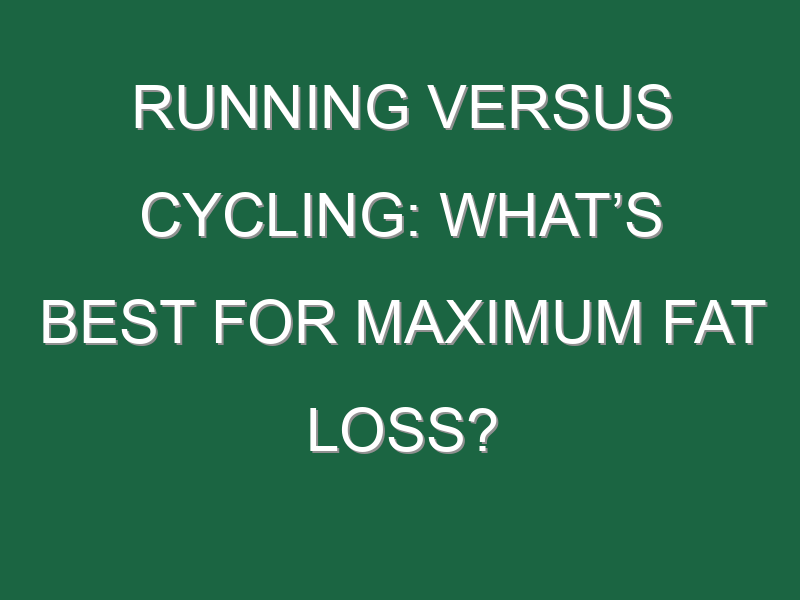By Butch Peterson
Cycling and running are two popular forms of exercise people use to get fit, cut fat, and subsequently, lose weight. Both types of exercises can be done outdoors or indoors, performed alone or in a group, and each burns a lot of calories. Of the two exercises, which is best for burning fat? Which of the two is best for you?
Well, according to one study, it turns out, performed at certain intensity, running burns more fat than cycling. That’s right; running is a better fat burner than cycling. But cyclists, don’t hang up your cleats just yet.
According to the study, performed on nine triathletes at the University of Capetown, South Africa, the fat-burning qualities of running are only significantly higher at lower intensities. As intensity increases, the difference in the amount of fat oxidation decreases. But if your aim is to burn the most fat, running at 60 percent effort is the way to go. As intensities in both types of exercises increase to 80 percent, the amount of fat burned drops in both activities, and the difference between the two is negligible.
More specifically, the study found that running burns approximately .7 grams of fat per minute at 60 percent intensity, while cycling burned .4 grams per minute at the same intensity. But as intensity increased to 80 percent, fat oxidation dropped to approximately .1 grams per minute for both activities. So no matter what form of exercise, at the higher intensities, carbohydrates took over the workload, and the fat burn drops.
Why does running burn more fat than cycling at low intensities? Good question. This is something the South African researchers could only speculate upon, and here is one possible cause:
Cycling might use fewer muscle fibers than running at the same workload, so those muscle fibers work harder, and subsequently tap into carbohydrates more at lower intensities. A study by Achten et al. suggests that during cycling, fewer muscle fibers are engaged than when running. In that case, the muscle strain during cycling would be more localized, resulting in more work for the muscles during cycling than running (Roberts & Alspaugh, 1972). If the stress on each muscle fiber is greater during cycling, then more energy could be pulled from carbohydrate stores, rather than fat stores. Hence, if more work is done by fewer muscle fibers, the carbohydrates could be tapped more so than fats (Carter et al. 2000).
So of the two, which is the best for you?
Running Versus Cycling
You lose weight when you burn more calories than you consume. Both activities burn a significant amount of calories without needing special skills or coordination. Which burns the most calories in the same amount of time? Running. That’s right, running burns more fat at low intensities and also burns more calories than cycling. A 140-pound person cycling at a moderate 14 mph pace burns about 300 calories in 30 minutes. But running at 6 mph, that same 140-pound person would burn close to 350 calories. Running burns more calories because your muscles are supporting more weight – there is no saddle to sit on for support and no coasting. Taking either activity up a hill or onto an incline will boost the calorie burn significantly.
The Benefits
Both running and cycling are cardiovascular activities that will improve your overall health and strengthen your heart. They each build the quads, hamstrings, calves, and firm the glutes. Both activities increase mobility in the hips. Since running is a greater weight-bearing activity, it can help build bone density. As either of the two (or both) of the activities becomes part of a lifestyle, the exercise can help to not only shed extra weight, but also keep it off. Add a sensible diet of healthy foods with a lower calorie intake than what you burn, and you will have a better-feeling, more ripped-looking body.
While running burns more fat, and burns calories faster, is cycling a waste of time? Not at all. Cycling is better for many people who want to lessen the impact on their joints. The pounding of running puts more stress on knees, ankles and hips, than does cycling. Also, people who are overweight may want to go cycling to lessen the pressure on their joints. Cycling may also be better for those with knee or back issues. Cycling is often easier on beginners. Getting started in running may cause more discomfort. Beginner runners should start off with slow walking and jogging before boosting up the intensity and risking joint pain or shin splints.
In the end, the best exercise activity to choose is the one you enjoy the most and the one you are likely to keep doing over time. Yes, running slightly edges out cycling in terms of fat burn and caloric consumption, but cycling might be easier on joints, a better choice for beginners, and a good alternative for people too heavy to run safely.
References:
What is the best way to increase your aerobic capacity when running? By Brian Lawler, Citizen-Times.com, December 1, 2009.
Higher Fat Oxidation in Running Than Cycling at the Same Intensities, Benout Capostagno and Andrew Bosch, International Journal of Sports Nutritition and Exercise Metabolism, 2010, 20, 445-55, 2010, Human Kinetics, Inc.
The post Running Versus Cycling: What’s Best for Maximum Fat Loss? first appeared on FitnessRX for Women.





